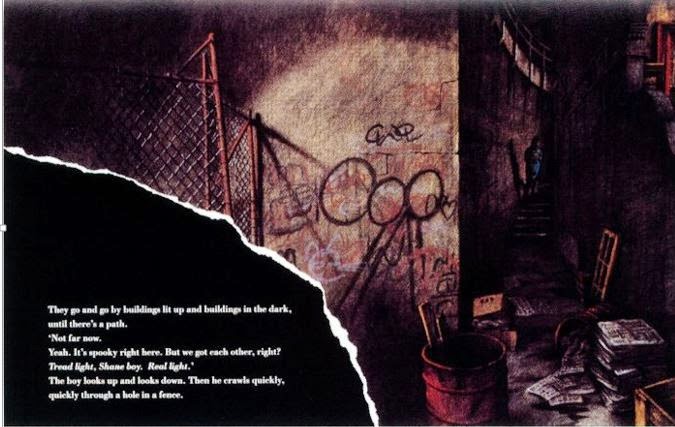I really dislike it when people say that picture books are just for young children or beginning readers. Maybe that has something to do with the fact that I never grew out of them myself and have an ever-expanding wish list. Casting slurs on my level of maturity and all that…
Anyway, as a primary teacher, picture books are one of my
favourite resources and I use them across all grade levels. Most people are
familiar with the quote: “A picture speaks a thousand words”. What I consider
to be one of the most beneficial characteristics of pictures is that these
“thousand words” are those of the reader. A good picture book is rich and open
to a variety of interpretations. It can spark discussion and engagement with
difficult or controversial concepts. Whilst they do provide an avenue into
literacy for struggling readers, it can be too easy to downplay what they have
to offer to students who have excellent skills in this area. The beauty of a
text that is so open to interpretation is that everyone can access it at their
own level and pull different meaning from it depending on their skills and
background knowledge. You could probably compare it to an allegory, which can
be read at face value or with the deeper meaning in mind.
Another advantage of picture books, as compared to
written texts like novels, is the interplay between the words and the pictures.
What is not said is just as, if not more, important than what is said. This
technique creates much of the humour and appeal in picture books, and can
inspire students to be creative and think outside of the box. The last element
that I particularly appreciate is that of “defamiliarisation”. Essentially this
refers to a technique by which familiar things are put in unfamiliar contexts
or described in unfamiliar ways. I find this really useful for extending the
thinking of those students who always want to know “the right answer” or tend
towards common or stereotypical interpretations of meaning.
In hindsight, I should have been aware of just how hard
it is to narrow my favourite picture books down to a short list! These are just
a few of the ones I like to use with older students:
·
I love anything by Shaun Tan. He is one of those
authors who has a very unique perspective and imagination. Every time I read
one of his books, I notice something new. Titles include Tales from Outer Suburbia, The Arrival, Rules of Summer and The Lost Thing.
·
Libby Hathorn’s Way Home is a really touching and confronting picture book about
homeless children. Very thought-provoking!
·
Anything at all by Oliver Jeffers! I am yet to
pick up a book by him that hasn’t made me laugh. At first glance they are very simple,
but when you read them closely they are incredibly creative in their simplicity,
which prompts some great discussion. Favourites include Once Upon an Alphabet, The Day the Crayons Quit, The Great Paper Caper,
The Heart and the Bottle, Stuck, The Incredible Book-Eating Boy, and This Moose Belongs to Me.
·
Imagine a
Day and Imagine a Night (Rob
Gonsalves & Sarah Thomson) – these books provide some of the best stimuli
for creating writing I’ve seen.
·
Erika’sStory (Ruth van der Zee), RoseBlanche (Roberto Innocenti) and Letthe Celebration Begin (Margaret Wild & Julie Vivas) are some of my
favourite picture books about the Holocaust.

·
Jeannie Baker’s two books Window and Belonging are
wordless and show changes in an environment over time. Really good discussion
starters and writing prompts!

·
The Peasant Prince (Li Cunxin & Anne Spudvilas) is the children’s version
of Mao’s Last Dancer. One of its best
points for use as a teaching resource is how it represents the fables and
stories that inspire the main character. You end up with rich,
thought-provoking “stories within a story”.

Thank you to Zana, my lovely enthusiastic daughter who is venturing out
as a new graduate teacher, for sharing some of the ways she uses picture
books in her teaching.







11 comments:
Wow, they all look and sound amazing. I haven't read one of these picture books. My son (13) and daughter (10) both love picture books still.
I recently discovered some new-to-us picture books which I will write up in my Sept/Oct book list. But I too was not familiar with any of these authors or titles, which is great. Thank you so much, Zana, for sharing this with us.
I still enjoy good picture books! We have a beautifully illustrated book of Twas the Night Before Christmas and I love it!
I hadn't read any of them either until dd brought them home.
Look forward to reading your list!
Me too, Karen.
Thanks for the reminder and for the great recommendations!
You've highlighted some of my favourite picture books here. Lovely to see someone else reviewing picture books too :-)
Oliver Jeffers "The Day the Crayons Quit" won the 2015 Texas Bluebonnet Award.
I strongly agree with the author that picture books are not only for the young students as they can also be used in custom essay writing service,I know that these are helpful for the reading beginers and it’s the beauty of picture books.
I agree 100% and I love this list! Thank you for being a part of Booknificent Thursday this week.
Tina
Post a Comment